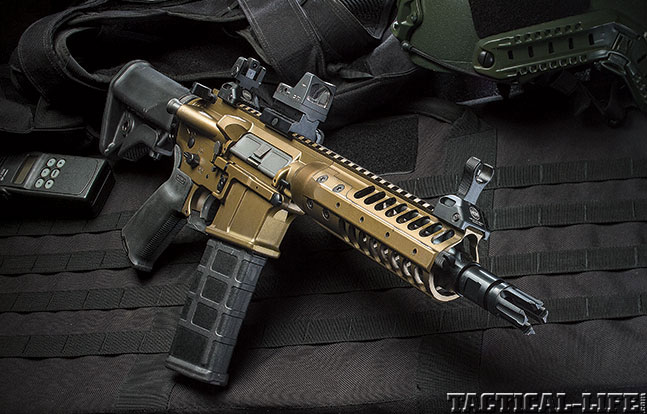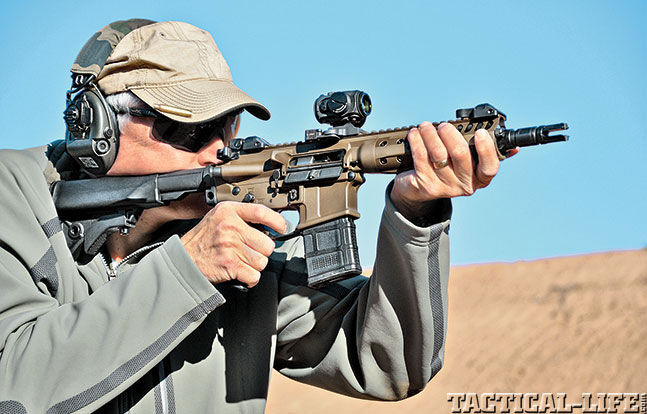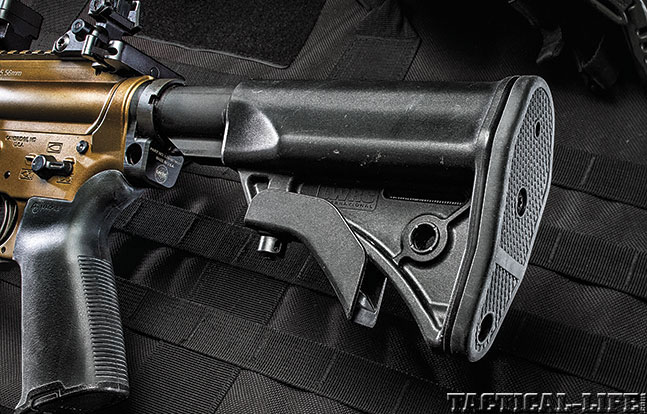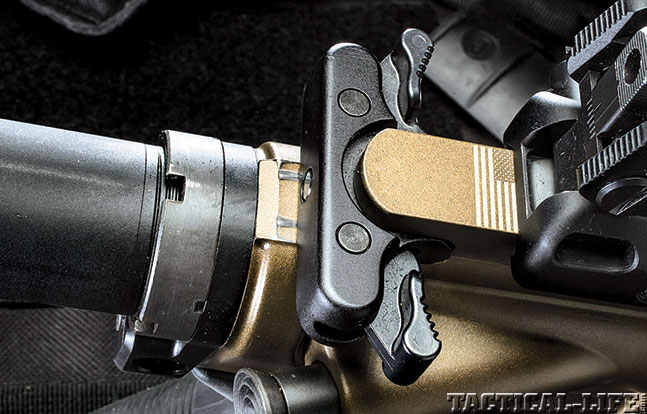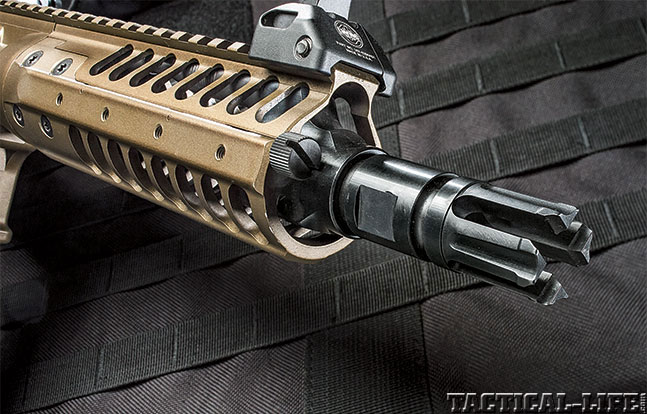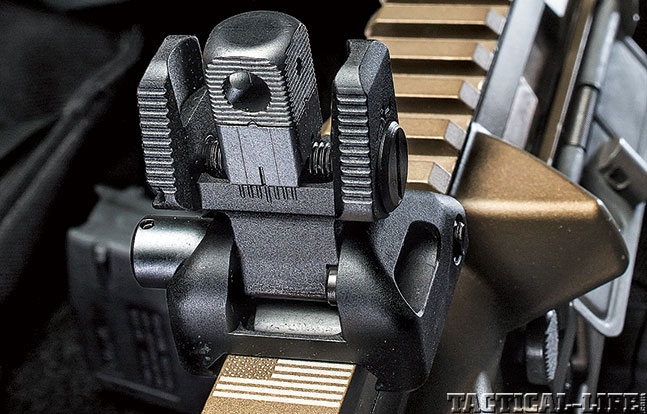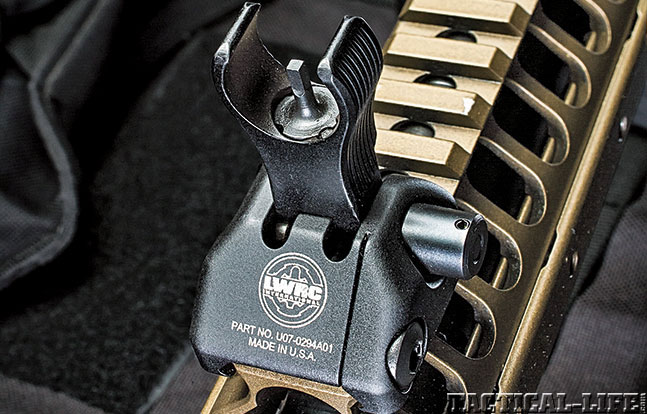The terms “personal security detail” and “protective security detail” invoke visions of large men in dark suits with Ray Ban Aviator sunglasses, ear buds and lapel microphones. The men and women who work on a “detail” represent the last line of defense for the protectee. The United States Secret Service is the highest-profile agency in this arena and, over the years, has refined the “art” of protection. Protection is a series of compromises where the protectee wants as much freedom as possible while the detail would like to have him in an armored bubble at all times.
- RELATED: Sneak Peek: Tricking Out LWRCI’s Six8 Warhorse in 6.8 SPC!
- RELATED: Gun Review: LWRCI M6-IC-SPR 5.56mm
Most agencies and details will not openly discuss the methods or equipment used in their duties. However, from time to time, the public gets a glimpse behind the curtain. One such case was the assassination attempt on President Reagan in 1981. Seconds after the shots were fired, a USSS agent produced an Uzi submachine gun. The Service later transitioned to the Heckler & Koch MP5, which has been observed on several occasions. In recent years, the changing threat matrix has resulted in many agencies transitioning from 9mm submachine guns to comparably sized platforms chambered for rifle cartridges. These rifles have generically become known as personal-defense weapons, or PDWs.
In 2006, long before the recent PDW excitement, LWRC International developed the PSD to meet the need for a compact 5.56mm. The original PSD was built on LWRCI’s proven M6 platform and featured LWRCI’s gas piston operating system, an 8.5-inch barrel and a legacy quad-rail handguard. My first experience with a PSD was in 2011, when I wrote a roundup article on SBRs. I requested a PSD upper for the project and paired it with my registered SBR lower. The little gun ran like a top, and at the end of the project, I purchased the upper. It has been my go-to SBR since that time and has logged a lot of range time.
Advertisement — Continue Reading Below
When LWRCI became involved in the U.S. Army’s Individual Carbine (IC) program, the goal was to improve the design and operating controls of the legacy M16 platform. The result was LWRCI’s new IC series of rifles, including the IC-PSD in 5.56mm NATO I was recently able to test.
Individual Carbine
Advertisement — Continue Reading Below
LWRCI’s IC rifles feature fully ambidextrous lower receivers that are ergonomically compatible for both right- and left-handed operation. The ambidextrous safety/selector is mirrored on both sides of the receiver, as is the bolt catch. The bolt catch on the right side is positioned to the rear of the magazine release button. This position allows it to be manipulated by the trigger finger of a right-handed shooter. The left-side magazine release consists of a large paddle that is recessed and protected by two raised ribs that prevent an accidental release. It is also positioned to allow it to be manipulated by the trigger finger of a left-handed shooter.
“I ran a series of informal drills and found the little gun was quick to index and had very little recoil, making follow-up shots remarkably easy.”
The new IC platform also uses a Monoforge upper receiver that features a low-profile handguard that is user-configurable with sections of Picatinny rail. Both the upper and lower receivers are forged and then struck twice, once before and once after being heat-treated. This processing is known in the industry as “coining” and allows LWRCI to maintain extremely tight tolerances. The lower receiver features a flared magazine well for faster reloads and a magazine stop to eliminate over-insertion of the magazine. All IC rifles also feature LWRCI’s large, ambidextrous charging handle.
Advertisement — Continue Reading Below
Like other LWRCI rifles, the new IC-PSD features a patented, self-regulating short-stroke piston system. The design eliminates the gas and carbon buildup in the receiver and bolt carrier group, and enhances reliability while reducing recoil and muzzle rise. Even with the piston system, LWRCI rifles retain substantial parts commonality with traditional direct impingement rifles. The piston is accessed by loosening two retaining screws and removing the top portion of the rail assembly. The design captures the retaining screws and allows for easy maintenance in the field.
The IC-PSD’s 8.5-inch, 41V45 steel alloy barrel is forged from an oversized barrel blank using high-pressure rotary hammers. This process results in near-perfect rifling that is molecularly stronger than other forms of rifling. The barrels are also treated with NiCorr, which is “more lubricious, harder wearing, more heat and corrosion resistant than normal hard chrome.” The company advertises a barrel life of 20,000 rounds, as compared to the 6,000 to 10,000 rounds for standard mil-spec barrels. The one-piece bolt carrier is designed to operate with the short-stroke piston and is also coated with a proprietary nickel coating to prevent corrosion and provide increased lubricity. The IC-PSD uses a specially designed, four-prong flash suppressor.
The IC-PSD carbine also utilizes a shortened buffer tube and a specifically designed buffer that was introduced with the UCIW. When combined with LWRCI’s proprietary stock, the IC-PSD collapses to a mere 24.75 inches. The IC-PSD is also equipped with LWRCI’s excellent Skirmish backup iron sights. The rear sight is a square post with two different aperture diameters that can be selected by rotating the post. The front sight consists of a post that is adjustable for elevation and features a semi-circular guard that is reminiscent of the sights found on an MP5. In my opinion, LWRCI’s flip-up iron sights are some of best available on the market today.
Advertisement — Continue Reading Below
Recently, LWRCI started offering a Cerakote ceramic coating as a factory option to the standard black anodizing. When Cerakote is applied over the top of the standard Type III hardcoat anodizing, it provides exceptional resistance to both abrasion and corrosion. Cerakote also has self-lubricating properties that enhance reliability, especially in dry and duty environments. Currently, the company offers Cerakote in Flat Dark Earth, OD green and bronze.
Compact Test-Fire
Advertisement — Continue Reading Below
I recently had an opportunity to spend a day on the range testing the new IC-PSD. I was immediately struck by how attractive the rifle was. The bronze upper and lower receivers are accented by the black stock, Magpul MIAD pistol grip, operating controls and rail panels. The iron sights, barrel and flash suppressor are also black, giving the new IC-PSD a very serious look. The IC-PSD has standard internals, with a trigger pull that measures 7.5 pounds. I ran a series of informal drills and found the little gun was quick to index and had very little recoil, making follow-up shots remarkably easy.
I installed a Leupold 2.5-8x36mm Mark 4 MR/T M2 tactical scope with a LaRue SPR mount for testing the carbine’s accuracy at 100 yards. The Leupold scope’s TMR reticle and brilliant light-gathering capabilities make it ideal for tactical operators as well as sportsmen. I have found this particular scope to be extremely versatile, and it has become my go-to glass for any AR evaluation.
Formal testing consisted of chronographing three premium loads and testing them for accuracy. I tested Hornady’s 55-grain TAP Urban and 62-grain TAP Barrier loads as well as ASYM Precision’s 70-grain Barnes TSX barrier load. The 55-grain TAP Urban ammo averaged 2,256 fps while the 62-grain TAP Barrier average 2,263 fps. ASYM Precision’s 70-grain Barnes load averaged 2,200 fps. At 100 yards, the IC-PSD proved to be exceptionally accurate with all three loads. The 55-grain Urban ammo produced a best five-shot group that measured 1.25 inches, while the 62-grain Barrier’s group measured 1.14 inches. The heavier ASYM load produced a group that measured 1.09 inches. I would like to thank Adam Pini, a sales representative with LWRCI, for also getting behind the rifle for the accuracy portion of the test. Adam is a competitive rifle shooter and did the IC-PSD far greater justice than I could have.
Advertisement — Continue Reading Below
Carrying a weapon in a protective environment is always a sensitive issue. With the exception of war zones, long guns are rarely exposed. In addition, tactical, black nylon cases are not appropriate in a five-star hotel or a VIP lounge at a private airport. In some situations, particularly during air travel, a low profile is more important than the immediate availability of a long gun. Enter the Pelican 1510 Carry On Case. As with all Pelican cases, the 1510 is built for hard use and features both a side carrying handle and an extended handle and wheels. When disassembled, my PSD fits perfectly in the 1510. The case’s 9-inch depth allows for two layers of storage to accommodate both the rifle and other operational equipment, such as radios, optics and additional magazines.
The IC-PSD is a highly refined person-defense weapon that is well suited to any operation mission requiring a compact, 100-percent reliable rifle. I liked it so much that I ordered one for personal use. Now I have to wait patiently for my Form 4 to clear the ATF. In the mean time, my original PSD will remain my go-to SBR.
For more information, visit lwrci.com or call 410-901-1348.
Advertisement — Continue Reading Below
